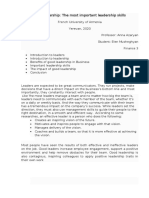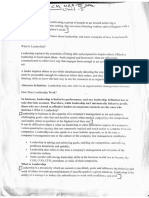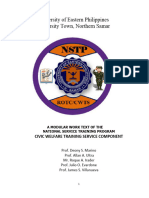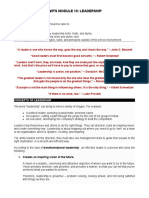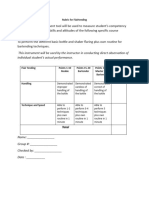0 ratings0% found this document useful (0 votes) 49 views9 pagesM7
Copyright
© © All Rights Reserved
We take content rights seriously. If you suspect this is your content,
claim it here.
Available Formats
Download as PDF or read online on Scribd
Chapter?
DEVELOPING THE ABILITY TO INFLUENCE
OTHER PEOPLE'S LEADERSHIP PERFORMANCE
Being a positive influence is important no matter where you
are in the company’s hierarchy. Influential people are more likely
to be promoted and to have their voices heard. Sharing techniques
to develop this important skill is a great way to empower your
employees.
According to Marry K. Pratt (2017), “Leadership is the ability
of an individual or a group of individuals to influence and guide
followers or other members of an organization.” Leadership
involves making sound and sometimes difficult decisions, creating
and articulating a clear vision, establishing achievable goals and
providing followers with the knowledge and tools necessary to
achieve those goals.
Objectives:
At the end of the chapter, the student should be able to:
* Define leadership;
¢ Enumerate role of leadership;
¢ Five leadership skills found in managers;
* Know the competencies for leadership;
* Enumerate leadership characteristics, leadership systems,
leadership styles; and
© Develop the ability to influence others.
Activate Prior Knowledge/Critical Thinking Question(s)
How do you influence others as a leader?
101�Chapter 7 Content
DEVELOPING THE ABILITY TO INFLUENCE OTHER PEOPLE'S
“LEADERSHIP PERFORMANCE”
POSITIVE INFLUENCE
Leadership
Leadership is the ability to positively influence people and
systems under one’s authority so as to have meaningful impact and
achieve important results.
Leadership is all about empowering people, inspiring people,
leading to change and shared vision.
1. Empower People
a. Individuals are given empowerment to create their own
dwellings.
b. When employees are empowered to make decisions,
they are contributing to the strategy and business
objectives of the organization.
2. Inspire People
This is the art of motivating a group of people to act
towards achieving a common goal.
3. Lead Change
Accepting and embracing change allows you to adapt to
change and become more flexible.
102
~�4. Shared Vision
Leaders provide a unity of purpose, while also
establishing the direction of the organization.
Five Leadership Skills Found in Managers
ys Ge
ify! How to bea
ul GooD MANAGER
Skills, ‘Qualities, (luributes
1. Communication
a. The most important skill of a leader is the ability to
communicate effectively. While the ability to strategize
is also crucial, strategies are nothing without a team that
understands how to carry them out.
b. Good communication skills help to develop better
understanding and beliefs among people and inspire
them to follow the principles and values which their
leader wants to inculcate in them.
c. Work on the best ways to communicate your vision to
others and listen to ideas.
2. Honesty and Integrity
The second leadership skill that should be possessed by
the manager is honest and having integrity in the workplace.
Tt means that you are taking responsibility of your decisions
and actions, especially when you make a mistake and being
honest and respectful, keeping your promises, and staying
engaged with your work, having upstanding character
traits and work ethics including sound judgment, honesty,
dependability, and loyalty.
3. People Management
a. Finding the right people and motivating them to work
towards your vision.
103�b. Developing a vision of where you want to be.
Awareness
Leaders should be aware and updated on how their
behaviors will impact to those they lead. Self-awareness in
leadership is important trait for a leader to cultivate.
Innovation
The leader's responsibilities are to map out the stages of
innovation and they need to recognize the different system,
processes, technology and skill sets. Leaders should know
how to adapt and apply innovation and creativity in
managing people and projects. Innovative leaders are often
inspiring productivity in new ways and through different
approaches that have typically been used and taken.
Innovation is important in workplace because it allows you
to bring new ideas to your role as a leader and also it paves
the way to bring more innovation into your workplace.
Competencies for Leadership Human Development and
Leadership Division of the American Society for Culture
104
1.
Navigator
The navigator is a trusted leader who steers his or
her people toward uncomplicated solutions, workable
outcomes, and powerful results. However, navigators are
leaders who also trust their people.
Communicator
Leadership communication is about inspiring and
encouraging an individual or a group by systematic and
meaningful sharing of information by using excellent
communication skills.
Learner
Continuously develops personal knowledge, skills, and
abilities through formal study, experience, reflection and
recreation.�4. Mentor
When mentors share their expertise with others, it
can elevate their credibility within the organization. It
demonstrates confidence in their abilities, indicates strong
leadership because of their willingness to nurture others,
and builds trust because of their investment in the success
of other employees.
5. Motivator
A motivational leader inspires their team with passion
and enthusiasm. They make people feel valued by investing
time and learning about their priorities, strengths and needs.
A motivated leader recognizes the value of hard work and
encourages their employee's potential through meaningful
challenges and goals.
7 Leadership Characteristics
‘Accountability
Taking responsibility for the
organization, community,
or self that the leader serves.
Courage
a. Ability to put aside
your fear of failure and
take the first steps.
b. Courage helps you
overcome the fear of
rejection and engage
your stakeholders.
Humility
What gives excellent leaders
their ability to mentor,
communicate, and learn
and understand that they
are servants of those that
follow.
105�Integrity |
The ability to discern what
is right from wrong and
commit to the right path
Creativity
The ability to — see
possibilities, horizons, and
futures that don’t yet exist,
enabling the leader to help
create a shared vision.
Perseverance
Sticking toa task or purpose,
no matter how hard or
troublesome. This is vital to
overcoming obstacles and
motivating subordinates.
106
Well Being,
The ability to stay healthy
in both work and play,
demonstrating the
importance of being ready
to implement leadership
competencies when needed.�Essential Elements of Leadership:
Leadership is the art of
motivating a group of
people to act towards
achieving a common goal.
Planning,
Understanding, basic
customerneedsand business
capabilities developing
long-term goal and near-
term priorities, formulating
human resources, goals and
policies, _ understanding
employees’ —_ perceptions
about quality and work.
Implementation
The process of putting a
decision or plan into effect;
execution.
Review
Tracking progress through
customer satisfaction and
internal measures of quality,
monitoring progress in
attaining improvement
objectives, and celebrating
successes.
107�Leadership Theory and Practice
Rational Legal Leadership
This is established by
policies, rules, and laws,
an example of government
officials who — legislate,
execute, and enforce
regulations.
32}!
Traditiono! Leadership Mode!
C6sb060
I\
wl
Traditional Leadership
It involves the passing of
position and power from
the generation to the next.
ae
Charismatic Leadership
The ability to inspire
others and usually is tied
to that person’s personal
characteristics.
Four Leadership Styles:
Coaching
Directing
It is a process in which
the managers __ instruct,
guide and oversee the
performance of the workers
to achieve predetermined
goals.
7 of
Coaching,
Leaders set the overall
approach and direction but
work with subordinates
and allow them to manage
the details.
108�Supporting
Leaders allocate — tasks
and set direction, but
the subordinates have
full control over the
performance of the work.
Delegating
Subordinates can do their
work with little supervision
or support. Once the work
is delegated, leaders take
a hands-off approach,
except when asked to
provide assistance by the
subordinate.
Effective Delegation
Tips for Becoming an Influencing Leader
Sw eONAR FY PP
10.
. Influence with good character
12.
13,
14,
15.
Provide opportunities for wins.
Believe in your people.
Serve others before yourself.
Connect with people.
Lead with authority but allow autonomy.
Give trust so you can earn trust.
Invest in the success of others.
Always show kindness and attention to others.
Stay humble.
Balance autonomy and authority.
Demonstrate openness.
Develop a good relationship with your employees.
Build commitment between yourself and your team
member.
Set a good example.
109






















